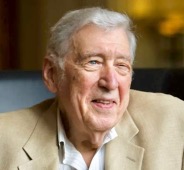#192– March 27, 2023

I.Andante, spaciously
https://www.youtube.com/watch?v=uk6KssUGn0o
II.Moderato
https://www.youtube.com/watch?v=dZyD1sJ7REk
III.Scherzo
https://www.youtube.com/watch?v=SyFMoUxo6fY
IV.Finale-Rondo
https://www.youtube.com/watch?v=m7eeoeLrZWc
Symphony No. 3 « In Praise of Winds” by American composer, conductor, educator, and performer Gunther Schuller is our Composition of the Week.
Symphony No. 3 was commissioned by the School of Music and the University of Michigan Bands for the Centennial celebration of the University of Michigan School of Music (1880 – 1980). The premiere performance took place on February 13, 1981, in Hill Auditorium, Ann Arbor, by the University of Michigan Symphonic Band, with dedicatee Robert Reynolds conducting, as part of the 21st CBDNA National Convention.
In Praise of Winds is structured in four movements.
I.Andante; II.Moderato; III.Scherzo and IV.Finale-Rondo.
It has an overall duration of 25 minutes, and it is scored for a large group, with suggested numbers of musicians on each part. Besides the standard wind orchestra instrumentation, the scoring calls for alto flute, double bassoon, E-flat Contrabass Clarinet, B-flat Bass Clarinet, 2 String Basses, Harp, Celesta as well as five percussion players.
“Drawing upon the influences of Schoenberg, Stravinsky, Ravel and Scriabin, Gunther Schuller’s compositional style is unique amongst works for band. He takes full advantage of the variety of tone colors available in the wind ensemble, and each performer has significant responsibilities. Because this is an extended work without clear tonal anchors, mature collegiate or professional performers are required, as well as a moderately sophisticated audience.” (Program Note from A guide to the Top 100 Works, Chad Nicholson)
Gunther Schuller began his professional life as a horn player in both the jazz and classical worlds, working as readily with Miles Davis and Gil Evans as with Toscanini; he was principal horn of the Cincinnati Symphony from age sixteen and later of the Metropolitan Opera Orchestra until 1959.
In the 1950s he began a conducting career focusing largely on contemporary music, and thereafter conducted most of the major orchestras of the world in a wide range of works, including his own. He was central in precipitating a new stylistic marriage between progressive factions of jazz and classical, coining the term “Third Stream” and collaborating in the development of the style with John Lewis, the Modem Jazz Quartet, and others.
An educator of extraordinary influence, he has been on the faculties of the Manhattan School of Music and Yale University; he was, for many years, head of contemporary music activities (succeeding Aaron Copland) as well as a director of the Tanglewood Music Center and served as President of the New England Conservatory. He has published several books and recently embarked on the writing of his memoirs.
Composition had a continual central presence in Schuller’s musical life: he wrote more than 180 works dating back to the beginning of his career when, at age nineteen, he was soloist in his own Horn Concerto with the Cincinnati Symphony Orchestra under Eugene Goosens. His works range from solo works to concertos, symphonies, and opera, and many fall outside of any genre.
One of his first works performed by a major orchestra was his Symphony for Brass and Percussion, played in 1949 by Mitropoulos. Schuller’s advocacy of other composers through performance, publishing, recording, teaching and administration had been as unflagging in its energy and scope as his pursuit of his own musical expression as performer, conductor, and composer.
Other works for winds include:
- Symphony for Brass and Percussion (1950)
- Diptych for Brass Quintet and Concert Band (1963)
- Study in Textures (1967)
- On winged flight (1989)


